Attention all digital marketers and business owners, are you ready to boost your online presence and drive conversions like never before? Then buckle up because mastering the basics of Google Ads is the ticket to success!
This blog post is a beginners guide to Google Ads basics in 2023. So hold on tight, and let’s get ready to hit the Google Ads highway!
Check out below video that explains Google Ads within 7 minutes,
🚀 Boost Your Google Ads with Digifix 🚀
Are you frustrated with your Google Ads not getting good results? Don’t worry! We’re here to help. At Digifix, our team of experts knows how to create ads that people love to click on. We use tools to find the best keywords that get you noticed by potential customers.
We’ll make sure your ads reach the right audience, and we’ll manage everything, so you don’t waste your money.
Let us take care of your Google Ads, and watch your business grow like never before. Contact us now and get ready to shine online with Digifix! 💼📈

Google Ads is an online advertising platform handled by Google. Currently, Google Ads is the most popular & mostly used online advertising platform. Millions of business owners use Google Ads to bring in new customers & boost sales.
Google Ads allows businesses to create & display ads for people to promote products & services. It has a pay-per-click method which means advertisers only have to pay when an internet user clicks their ad.
Why should I use Google Ads?
Are you wondering if Google Ads is worth the investment for your business? Let these compelling benefits ease your mind and show you just how valuable Google Ads can be.
1.Reach a wide target audience.
Google is the most used search engine, with millions of active users daily. When you advertise on Google, your ad will appear on the Google search network, Google display network & partners of Google.
That means your ad will appear in front of millions of active users who are searching & browsing the internet.
Assume you run a flower shop that mainly focuses on personalised floral arrangements for special occasions. You can reach millions of people who actively search for flower arrangements for weddings, anniversaries, birthdays, and other special events by using Google Ads.
So, how will this benefit your business? It will expand your customer base and boost sales & website traffic.
2.Google Ads are cost-effective.
Since this is a pay-per-cost model, advertisers only need to pay for the clicks they get for their ads. So, it is a cost-effective advertising option for businesses of all sizes. Unlike other advertising forms, Google Ads only charge when someone clicks your ad.
You can control your advertising costs & get the maximum outcome from the money you spend. There is a possibility to set a daily budget for your campaign & Google will automatically set the bidding strategy according to your budget.
And if you need to stop your Google Ads campaign, you can do it anytime.
3.Highly targeted ads.
Since Google Ads has many targeting options, you can create ads that will reach the right audience. With Google Ads, you can get the maximum outcome from your advertising budget for your campaign.
You can target the keywords that people search for in your campaign to approach the right target audience. For example, if you own a flower shop, you can target the search terms like “Flower bouquet for my boyfriend,” “Flowers for anniversary,” and “Flowers for valentine.”
You also can target your ad based on your target audience’s demographic like age, gender, location & interest.
For example, if you own a flower shop, you can target people in your area who are searching for flower arrangements for special events.
Apart from those, you can target people based on their interests & behaviours. All these highly targeted options let you reach the right target audience.
4.Measure results easily.
With Google Ads, you can monitor & measure the results of your Google Ads campaign. You can see how your ads perform & how they influence your business, thanks to the reports & analytics in Google Ads.
You can track the clicks on your ads, impressions, conversions, cost per click & more. With these analytics, you can understand the areas to improve for better results. Then you will be able to make informed decisions.
You can read our blog article on Benefits of Google Ads for businesses
Basic terms in Google Ads:
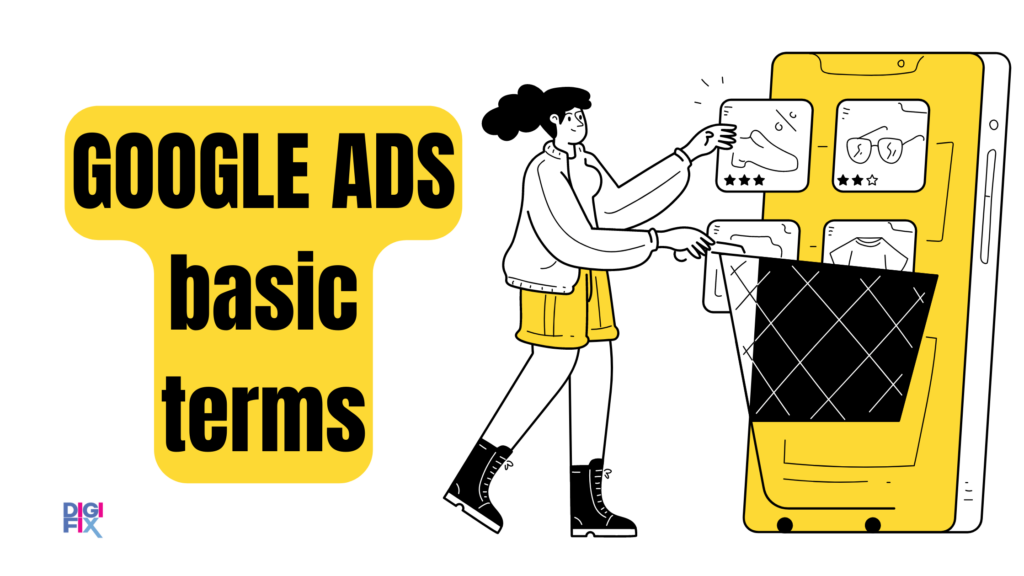
Familiarizing yourself with the below terms will help you navigate the platform easily. And also, make the most of your advertising efforts. Let’s dive into some essential Google Ads vocabulary!
1.Ad campaign
An ad campaign is a set of ads that have a common objective. Ad campaigns help to organize ads & allow them to target specific goals.
2.Ad Group
A unit with ads, keywords & target settings is an ad group. Ad groups help to group related ads & keywords based on objectives. One Google ad account can have multiple ad groups.

Each ad group has a set of ads that target a distinct audience & use similar keywords.
3.Ad rank
The ad rank determines the placement of your ad (where your ad will be displayed.) If you have a higher rank, more people will see your ad & get more clicks.
4.Ad extensions
An ad extension expands an ad with extra information like phone numbers, links & more. Ad extensions encourage people to click an advertisement by providing more information.
For example, in a call extension, you can add your phone number & make it easy for potential customers to contact you directly.
5.Ad copy
Google ad copy is the text displayed in a Google ad. It is the content people see when your ad is displayed on Google search results, websites & other platforms. An ad copy should attract potential customers & persuade them to click your ad.

6.Keywords
A word or phrase you target in your ad appears in front of people when they search for that term. Ex: if you own a bakery, you can target keywords like best bakeries near me and gluten-free bakeries.
7.Bidding
Bidding is setting the highest amount you’re ready to pay for each click on your ad. It affects how often your ad is displayed & where it places on the search results page.
Example: If you bid $0.50 per click for the keyword “sport shoes,” you are ready to pay up to $0.50 each time someone clicks on your ad after searching for “sports shoes.”
8.Campaign type
Google ads offer search campaigns, display campaigns, video campaigns & shopping campaigns. Each of these campaign types are for different objectives. You can select any campaign type that is relevant to your purpose.
For example, if you want to promote your products to people searching for those products using specific keywords, you can choose a search campaign type.

- Search ads are text ads that appear in Google search results page.
- Display ads are the image ads that appear on websites in Google display network.
- Video ads are the short ads that appear on YouTube.
- Shopping ads appear on search results & Google shopping tab.
9.Click-through-rate (CTR)
CTR refers to the percentage of people who clicked your ad when they saw it. A higher click-through rate indicates that your ad is relevant to users’ search queries.
For example, if you had five clicks and 100 impressions, your CTR would be 5%.
10.Conversion rate
The conversion rate refers to the percentage of users who completed a desired action, like making a purchase or filling out a form, after clicking on your ad.
11.Display network
A group of websites and apps that partner with Google to show ads is the display network. Display network helps to reach potential customers when they are on other sites.
For example, if you create a banner ad to promote your art store, that will appear on art-related blog sites & other sites in the display network.
12.Impression
The impression is the number of times your ad is shown to an internet user. For example, if your ad is displayed 100 times on Google SERP, the impression is 100.
13.Pay-per-click (PPC)
A method where advertisers pay a fee each time someone clicks their ad. So, the advertiser only needs to pay when his ad gets clicks. So, it is a cost-effective method.
14.Quality score
The quality score measures the relevancy & quality of an ad & its keywords. Higher quality scores help to get better ad positions.
15.Conversions
Conversions refer to the number of people who took a desired action like, purchasing your products or services, signing up for a newsletter, filling out a form, or anything you want.
For example, if you gained 50 purchases from your ad campaign, the conversions are 50.
16.Cost-per-conversion (CPC)
The average cost for each conversion is the cost-per-conversion or CPC. By calculating CPC, you can measure the effectiveness of your ad campaign. For example, if you spent $100 on ads and got ten conversions, your CPC is $10.
17.Landing page
The landing page is a web page where users are directed when they click on your ad. A landing page should be relevant to the ad content. For example, if your ad promotes sportswear for women, the landing page should lead directly to that product’s page on your website.
18.Negative keywords
Negative keywords are the keywords that you exclude from triggering your ad. For example, for a campaign that promotes new laptops, you can add “used laptops” as a negative keyword. Then your ad will not appear for that keyword.
Types of Search Ads:

1.Search Ads
Text-based search ads are at the top or bottom of the search results page. You can identify them because they are marked as “Sponsored.”
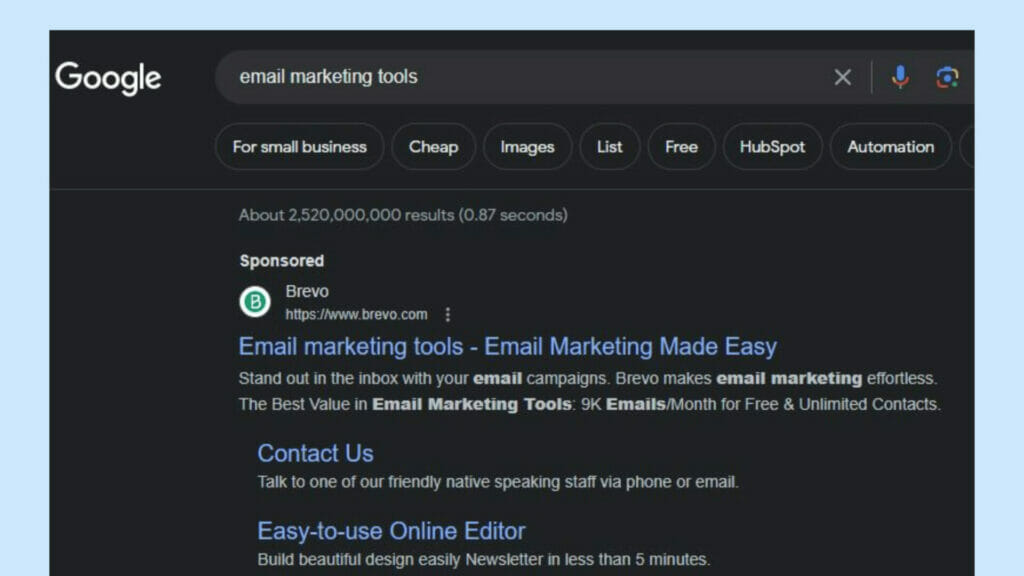
Search Ads are the most popular type of Google Ads. Search Ads appear when someone searches on Google for products/services related to your business. Search ads focus on keywords you use. Those are to reach potential customers who actively search for information.
A search ad has a headline & description & a display URL that directs people to your website.
Search ads are highly targeted, which means only the people who look for products/services related to yours will see your ad. You can bring high-quality traffic to your website with search ads.
2.Display Ads.
Display Ads are the ads that appear on websites & apps in the Google Display Network (GDN). Google Display Network consists of millions of websites partnered with Google to display their ads.
Display ads have many forms like animated banners, videos, interactive elements & static images. Display ads are typically image ads that win attention away from web page content.

You can promote your products/services to a larger audience and increase brand awareness with Display ads.
Display ads don’t rely on keywords & use targeting options like demographics, interests & location to reach potential customers.
3.Shopping Ads.
Shopping ads appear in the results when someone searches for products related to your business. Shopping ads help to promote e-commerce businesses to promote their business & reach their target audience.
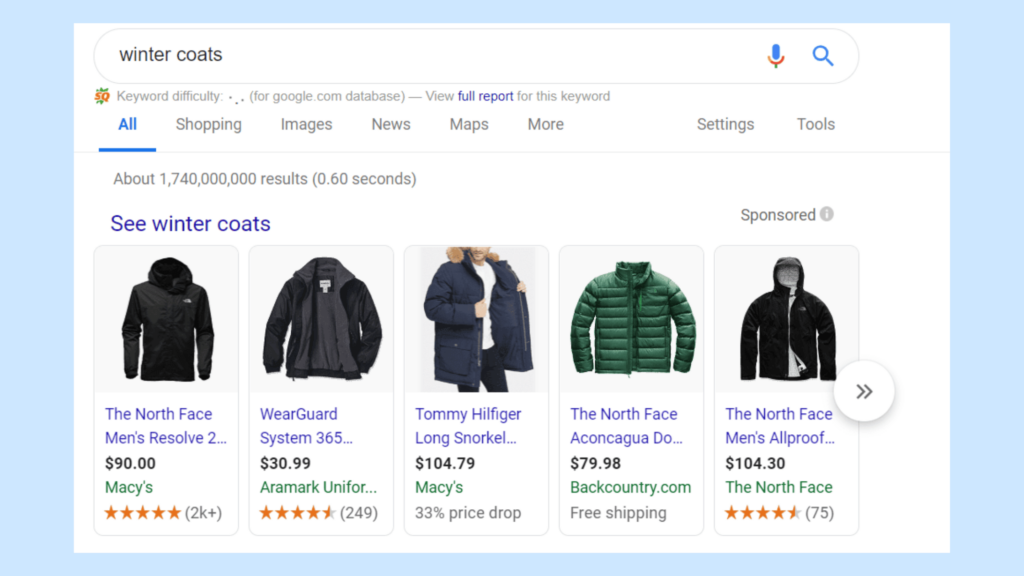
Google Ads provides a clear & brief product description & helps to reach potential customers who actively search for products like yours.
Shopping Ads are a fantastic way to connect with clients who are prepared to make a purchase, and they can help you attract high-quality visitors to your website and boost sales.
Shopping ads help you to promote specific products or product lines.
4.Video Ads.
Video Ads are featured on video-based platforms like YouTube. They help businesses to reach a large audience to increase brand awareness & conversions.

A video ad can be up to 6 minutes long and have a variety of components, such as graphics, music, and voiceover. They frequently serve to narrate a story, highlight a good or service, or display how to use a specific product.
On YouTube, video ads can appear before, during, or after a video and can be tailored to particular audiences based on information like demographic factors, preferences, and location.
Video advertisements are an effective way to connect with a large, engaged audience and promote your brand.
Google Ads’ best practices
- Set clear goals.
Any advertising campaign should have a clear goal. The 1st step in creating your ad campaign is to have a clear & measurable objective. It will help you to make better decisions, stay focused & measure success.
Examples of clear goals for your Google Ads campaigns are:
(a). Increase website traffic/drive more traffic to your website.
(b). Generate leads.
(c). Boost sales.
(d). Increase brand awareness.
When you have a clear goal in mind, you can create the most relevant ads & select the proper keywords. It will generate the most effective ad campaigns.
- Using the right keywords.
Using the right keywords is critical to get the most effective outcome from an ad campaign. Choosing the proper keywords is critical to assure that your ads reach the right audience & appear when potential customers are actively exploring products or services like yours.
Here are some suggestions for using the right keywords in your Google Ads campaigns:
- Choose keywords that are highly relevant to your products.
- Use keyword research tools, like Google’s Keyword Planner, to find relevant keywords & their search volume and competition.
- Consider using long-tail keywords, which are more specific and have lower search volumes.
- Use negative keywords to prevent your ads from showing for unrelated searches. For example, if you sell high-end luxury clothes, you could add “cheap” as a negative keyword to avoid clicks from users looking for inexpensive clothes.
- Use different keyword match types to manage when your ads will appear.
- Grouping similar keywords helps to create more targeted ad copy and improve Quality Score.
How Google Ads Work:
Think of Google Ads as a roleplay. There are three major roles in this role play: The searcher, advertiser & Google ads platform. All three work together to make Google ads work. Shall we see how Google ads work?
- An advertiser bids on keywords in Google ads.
Bidding on keywords lets Google know which keywords an advertiser wants his ads to appear on SERP. An advertiser can adjust his ads to suit his budget. And he can pause or stop his ad campaign at any time he wants.
So, if you are an advertiser who wants to promote a certain product, you can bid on the most relevant keywords. Then, Google will show your ad to relevant people.
- Potential customers use keywords to search on Google.
Then, people use the keywords you bid on previously to search for products or services. For example, if a person needs sports shoes, he can use different keywords like cheap sports shoes, Nike sports shoes, white sports shoes & more.
- Google shows your ads to relevant keywords based on ad rank.
Google ranks your ads based on the ad’s quality score & bidding amount to show your ad to people. If both factors are better, you will get a higher rank.
- People click the ads that appear on SERP.
When people use keywords to search for products, they will see the ads appear on SERP & click on them. If you have what they seek, they will convert to a conversion.
In simple terms,
- A company creates an account and sets up ad campaigns, which include one or more ad groups.
- Within each ad group, the company creates ads and selects keywords that are suitable for the products or services being advertised.
- When someone searches for a keyword that matches one of the business’s chosen keywords, Google may show their ad in the SERPs or on the Display Network.
- When a user clicks on the ad, they are taken to the business’s website or landing page.
- The cost of each click is decided by an auction system, in which companies bid on keywords, and Google decides which ads to display based on the relevancy of the ad and its landing page.
Conclusion
To sum up, Google Ads offers companies a powerful platform for connecting with their target market and generating sales.
Success depends on understanding the fundamentals of how it operates, including the meanings of important terms like keywords, ad groups, and quality score. Businesses can enhance their return on investment from Google Ads by developing relevant and targeted campaigns, tracking and modifying performance, and consistently checking and optimising.
Learning the fundamentals of Google Ads can pay off in significant and measurable ways, whether you’re a small business owner or a digital marketer. If you want any support for managing your Google Ads, we are a Melbourne based paid search agency, that help many businesses to handle their Google Ads campaigns. Contact us by visiting our website.
You may like the following articles as well,
Do you want more traffic?
—————
Hi, we are an Australian digital agency doing groundbreaking work to help a business like yours reach its full potential. My only question is will you qualify for our services?
Do you want more traffic?
—————
Hi, we are an Australian digital agency doing groundbreaking work to help a business like yours reach its full potential. My only question is will you qualify for our services?



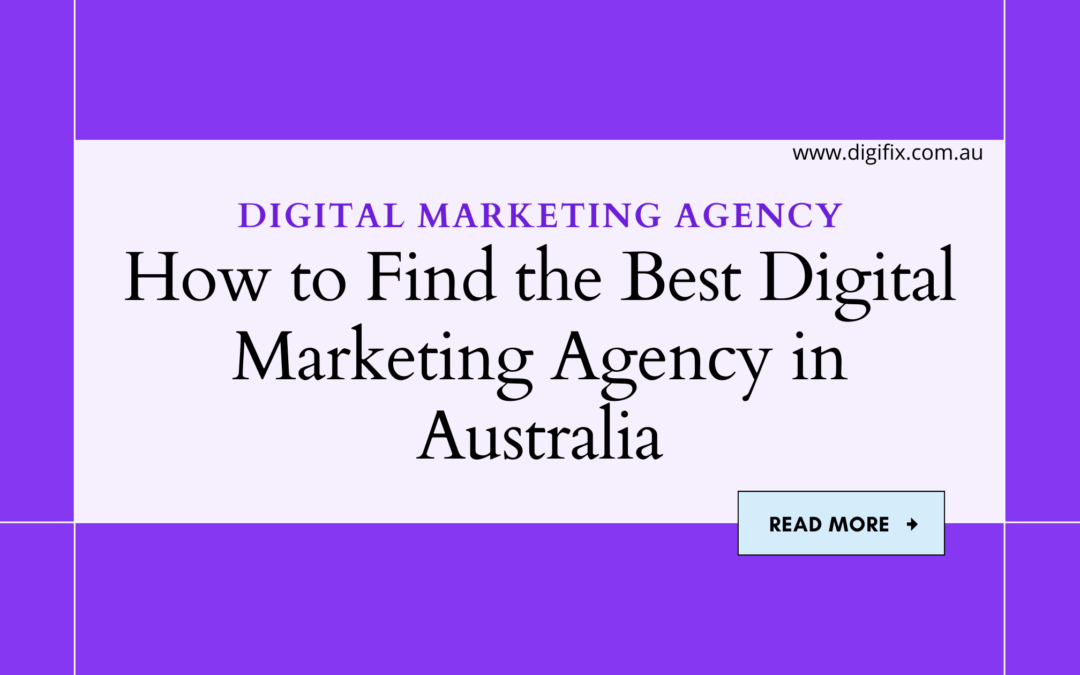
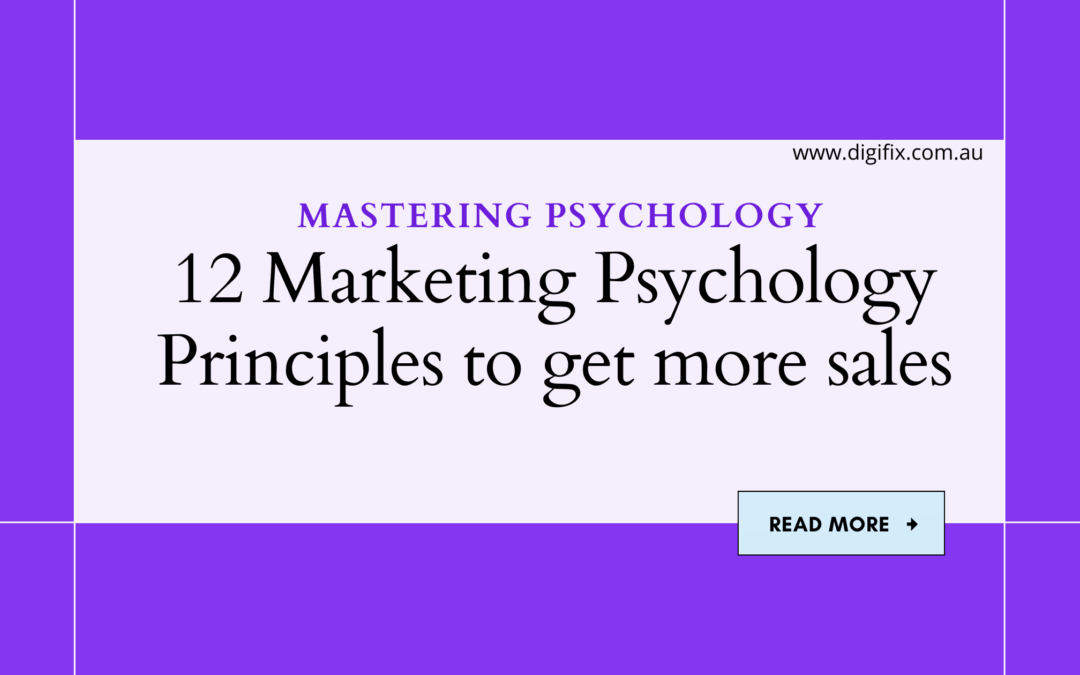
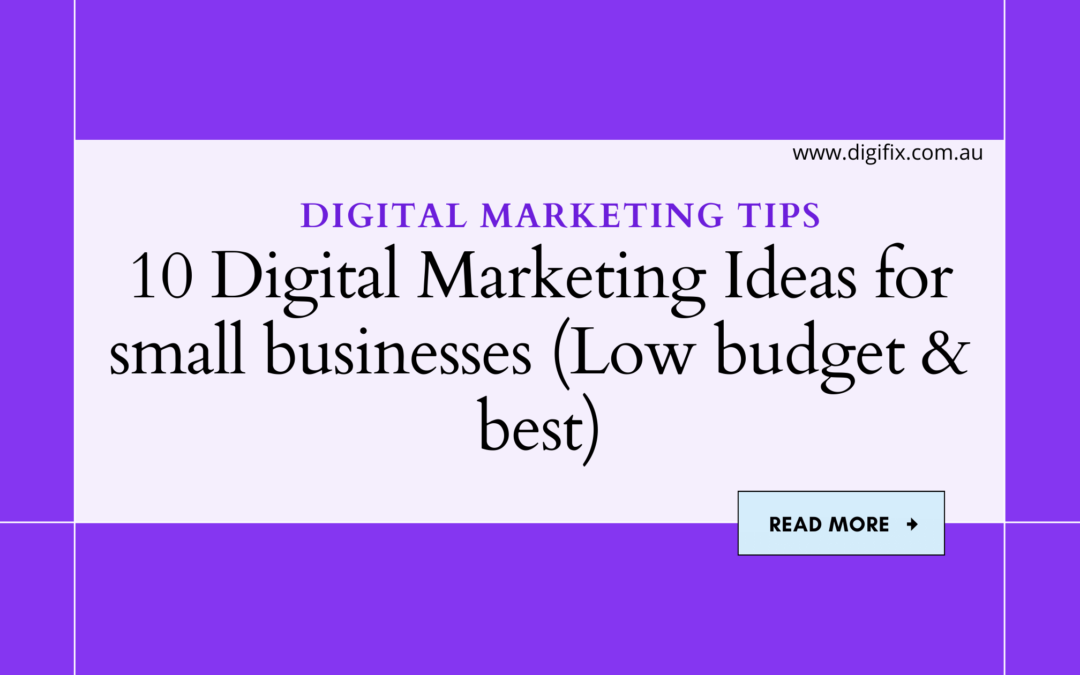

This blog has explained everything about Google Ads. Thanks for sharing your explanation.